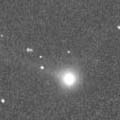
|
It had been observed while brightening rapidly until the perihelion passage on Apr. 19, although it located extremely low in the evening sky. It reached to 6.7 mag on Apr. 17 (Juan Jose Gonzalez). Although it had been unobservable for a while, it appeared in the morning sky in the Southern Hemisphere. Now it is 7.8 mag (May 9, Alexandre Amorim). It will be bright and observable for a while after this. In the Northern Hemisphere, it appears in the morning sky at 12 mag in June. But it locates only 20 degree high at most, and it will be fading rapidly.
Date(TT) R.A. (2000) Decl. Delta r Elong. m1 Best Time(A, h)
May 19 1 6.06 -11 34.8 0.507 0.782 49 9.1 5:21 (262, 31)
May 26 0 40.67 -15 54.1 0.511 0.905 63 10.2 5:26 (257, 45)
|
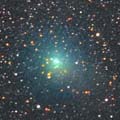
|
New comet discovered in March in the Southern Hemisphere. However, it appeared in the morning sky also in the Northern Hemisphere in early April, and it is already observable in the excellent condition now. It passed near by the earth in mid April, and reached to 7.6 mag (Apr. 18, Juan Jose Gonzalez). But it is already fading, and now it is 9.6 mag (May 16, Juan Jose Gonzalez). After this, it keeps observable until it fades out in the Northern Hemisphere. It will be visible visually until July.
Date(TT) R.A. (2000) Decl. Delta r Elong. m1 Best Time(A, h)
May 19 15 41.69 62 40.5 0.814 1.381 97 9.7 23:49 (180, -8)
May 26 14 49.28 64 27.4 0.983 1.449 93 10.3 22:30 (180, -9)
|
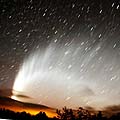
|
Excellent great comet, few times in a lifetime, for southern people. It reached to -5.5 mag on Jan. 14 and 15, brighter than Venus, and visible even in daytime. Then it appeared in the evening sky in the Southern Hemisphere and many people enjoyed a fantastic view of a beautiful great comet, a enormous curving tail with so many striae over 50 degrees. Now it is observable both in the evening and morning. It has already faded down to 10.9 mag (May 16, Walter Ruben Robledo). In the Southern Hemisphere, It keeps observable almost all night until the comet has gone. It will never be observable again in the Northern Hemisphere.
Date(TT) R.A. (2000) Decl. Delta r Elong. m1 Best Time(A, h)
May 19 5 25.56 -84 33.4 2.161 2.608 104 10.9 18:30 ( 6, 37)
May 26 7 33.60 -84 10.0 2.230 2.709 107 11.2 18:27 ( 5, 39)
|
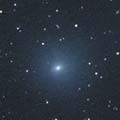
|
Although it was so faint as 13.8 mag in March (Mar. 17, Alan Hale), it brightened very rapidly in early April, and it reached to 8.7 mag on Apr. 10 (Werner hasubick). Then it faded a bit, and now it is 10.6 mag (May 16, Juan Jose Gonzalez). The comet is very large, extremely diffuse. It is fading, and getting lower rapidly now. It will be unobservable in late May.
Date(TT) R.A. (2000) Decl. Delta r Elong. m1 Best Time(A, h)
May 19 7 34.19 21 52.6 1.585 1.288 54 11.1 18:30 (139, 21)
May 26 7 27.99 22 33.3 1.765 1.286 45 11.3 18:27 (134, 16)
|
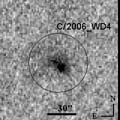
|
Originally considered as a peculiar asteroid, but revealed to be a comet. It approached to Sun down to 0.6 A.U. in late April, then it will pass very near by Earth in May. Now it is bright as 14.1 mag (May 2, Ernesto Guido and Giovanni Sostero). In the Northern Hemisphere, it will appear at 12.5 mag in the evening sky on May 23, then it moves eastwards very fast. It keeps observable in the evening sky, but it will fade out rapidly. It will be 15 mag in early June, and will be fainter than 18 mag in late June. In the Southern Hemisphere, it is also observable in the morning low sky from late April to mid May. Because it is an extremely tiny comet, it may fade out much faster than expected.
Date(TT) R.A. (2000) Decl. Delta r Elong. m1 Best Time(A, h)
May 19 3 42.84 3 2.0 0.285 0.743 16 12.4 18:30 ( 90, -7)
May 26 7 37.26 19 45.6 0.313 0.839 48 12.9 18:27 (136, 21)
|
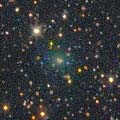
|
It became brighter than expected, and now it is visible visually at 13.2 mag (May 12, Carlos Labordena). However, it is getting lower gradually in the evening sky, and it will be too low to observe in early June. It is not observable around the perihelion passage in July in conjunction with the sun. Then it moves to the southern sky, and it will be unobservable in the Northern Hemisphere.
Date(TT) R.A. (2000) Decl. Delta r Elong. m1 Best Time(A, h)
May 19 6 27.80 33 14.9 2.652 1.977 39 13.6 18:30 (135, 3)
May 26 6 46.24 31 37.4 2.661 1.943 36 13.5 18:27 (133, 4)
|
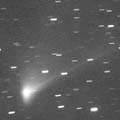
|
After the perihelion passage on Apr. 4, it appeared in the morning sky and it was so bright as 5.5 mag (Apr. 10, Michael Jager and Gerald Rhemann). Then it is fading rapidly. But it is bright as 12.2 mag still now (May 19, Yoshimi Nagai). It may keep brighter than this ephemeris and visible visually for a while.
Date(TT) R.A. (2000) Decl. Delta r Elong. m1 Best Time(A, h)
May 19 21 8.79 18 21.9 0.626 1.200 91 13.5 5:21 (181, 37)
May 26 20 25.31 15 35.0 0.606 1.326 107 14.0 4:14 (180, 39)
|
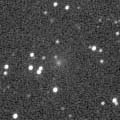
|
Getting higher in the morning sky. It is already visible visually at 13.5 mag (May 14, Alan Hale). It will brighten rapidly after this, and reach to 9 mag in July. However, it moves southwards very fast in August. It is only observable until mid August in the Northern Hemisphere. On the other hand, it keeps low and hard to observe until mid July in the Southern Hemisphere.
Date(TT) R.A. (2000) Decl. Delta r Elong. m1 Best Time(A, h)
May 19 23 20.11 36 47.3 1.976 1.692 58 14.0 5:21 (207, 12)
May 26 23 18.93 39 8.6 1.778 1.609 63 13.5 5:26 (200, 12)
|

|
It had been bright as 12-13 mag and visible visually almost always from 2006 July to 2007 April. However, now it is not observable. It will appear in the morning sky again in late July.
Date(TT) R.A. (2000) Decl. Delta r Elong. m1 Best Time(A, h)
May 19 4 47.49 29 8.3 6.866 5.911 17 14.0 18:30 (118,-11)
May 26 4 53.76 29 14.3 6.896 5.913 12 14.0 18:27 (116,-14)
|
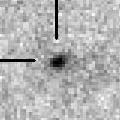
|
It appeared in the morning sky. It is bright as 14.7 mag (May 13, Ernesto Guido and Giovanni Sostero). It will be getting higher gradually after this, and it will keep bright as 15 mag and observable in good condition for a long time until autumn.
Date(TT) R.A. (2000) Decl. Delta r Elong. m1 Best Time(A, h)
May 19 0 44.50 12 38.4 2.679 2.056 42 14.6 5:21 (238, 20)
May 26 0 57.79 14 49.9 2.634 2.060 45 14.6 5:26 (233, 21)
|
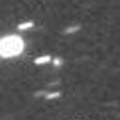
|
Now it is 14.9 mag (May 7, Ken-ichi Kadota). It will be observable at 14.5 mag from spring to summer both in 2007 and 2008. The condition is good, and it may be visible visually.
Date(TT) R.A. (2000) Decl. Delta r Elong. m1 Best Time(A, h)
May 19 18 30.86 -6 38.8 5.082 5.861 136 14.8 2:47 (180, 62)
May 26 18 24.03 -5 59.0 4.996 5.846 144 14.8 2:13 (180, 61)
|
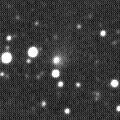
|
It kept 12 mag for over half a year since last June. It was still bright as 12.6 mag on Mar. 9 (Edwin van Dijk). But it has already started fading, and will be already too faint to see visually. However, the fading is slow. The comet will be fainter than 18 mag in 2008. In the Northern Hemisphere, it keeps observable until that time. In the Northern Hemisphere, it keeps observable all night for a while after this.
Date(TT) R.A. (2000) Decl. Delta r Elong. m1 Best Time(A, h)
May 19 3 30.63 68 37.6 3.462 2.902 49 14.8 5:21 (206,-34)
May 26 3 51.47 67 55.6 3.554 2.958 47 15.0 5:26 (207,-33)
|
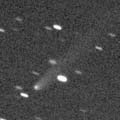
|
It has been visible at 13.5 mag for a long time since 2005 autumn until 2006 spring. It was still bright and visible visually as 14.2 mag in winter (Dec. 22, Seiichi Yoshida). However, it has already faded down to 16.2 mag (May 2, Ken-ichi Kadota). Fine tail is visible on CCD images. It will be getting lower gradually after June, and will be too low to observe in September.
Date(TT) R.A. (2000) Decl. Delta r Elong. m1 Best Time(A, h)
May 19 12 38.47 21 48.5 5.442 5.999 119 15.0 20:51 (180, 33)
May 26 12 37.46 21 10.9 5.552 6.025 113 15.1 20:23 (180, 34)
|
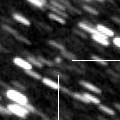
|
Now it is 15.8 mag (May 3, Tony Farkas), brightening as expected. It will reach to 14.5 mag in 2007 summer. However, it moves in the southen sky. In the Northern Hemisphere, it rises up to 20 degree at best in May, then it becomes unobservable in July.
Date(TT) R.A. (2000) Decl. Delta r Elong. m1 Best Time(A, h)
May 19 20 54.58 -29 6.0 3.225 3.685 109 15.2 5:10 (180, 84)
May 26 20 51.79 -31 12.6 3.082 3.652 116 15.1 4:40 (180, 86)
|

|
Now it is 15.2 mag (Feb. 24, Ken-ichi Kadota). It will reach to 11 mag in 2008 spring. It keeps moving in the southern sky until that, so it keeps locating very low in the Northern Hemisphere. Now it is observable in good condition in the Southern Hemisphere, but already not observable in the Northern Hemisphere. In the Northern Hemisphere, it will be observable again in a short time in the very low sky at dawn in November at 13 mag. After 2008 March, it will be visible visually at 11 mag in the morning low sky.
Date(TT) R.A. (2000) Decl. Delta r Elong. m1 Best Time(A, h)
May 19 5 44.25 -26 59.2 5.361 4.857 55 15.3 18:30 ( 78, 32)
May 26 5 51.77 -26 38.3 5.336 4.807 53 15.3 18:27 ( 76, 29)
|
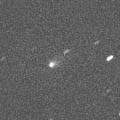
|
It is observable in good condition in the Southern Hemisphere, although it is already not observable in the Northern Hemisphere. It has been 13-14 mag for a long time since last autumn. It is 12.5 mag visually, much brighter than this ephemeris (Apr. 17, Michael Mattiazzo). However, it will be fading gradually after this.
Date(TT) R.A. (2000) Decl. Delta r Elong. m1 Best Time(A, h)
May 19 15 49.85 -72 51.1 2.028 2.755 126 15.3 0:07 ( 0, 52)
May 26 15 39.04 -71 37.9 2.057 2.809 129 15.4 23:23 ( 0, 53)
|
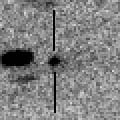
|
New periodic comet. Now it is bright as 15.5 mag (May 19, Ken-ichi Kadota). It will be observable in very good condition at 14 mag from summer to autumn. It may be visible visually. However, it was not discovered at the previous apparition in 1999. So it may be bright temporarily in outburst.
Date(TT) R.A. (2000) Decl. Delta r Elong. m1 Best Time(A, h)
May 19 22 51.07 -5 46.2 2.410 2.371 75 15.7 5:21 (226, 52)
May 26 23 1.81 -5 6.4 2.320 2.359 79 15.6 5:26 (218, 54)
|
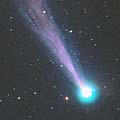
|
It reached up to 4 mag in 2006 autumn. But it had faded down to 10.5 mag on Jan. 11 (Carlos Labordena). It had been unobservable for a long time since that, but now it is appearing at dawn again. Now it is 15.8 mag (Apr. 28, Ken-ichi Kadota), fading as predicted. After this, it keeps observable until it becomes fainter than 18 mag in autumn.
Date(TT) R.A. (2000) Decl. Delta r Elong. m1 Best Time(A, h)
May 19 23 4.30 -12 14.9 3.660 3.540 75 15.6 5:21 (237, 55)
May 26 23 4.96 -13 4.7 3.617 3.619 82 15.7 5:26 (227, 60)
|
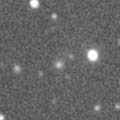
|
Now it brightened up to 15.7 mag (Apr. 28, Ken-ichi Kadota). It keeps 15.5-16 mag for one year and a half after this until 2008 summer. However, because the comet moves southwards, it is only observable until 2007 June in the Northern Hemisphere.
Date(TT) R.A. (2000) Decl. Delta r Elong. m1 Best Time(A, h)
May 19 10 14.10 -1 39.6 3.017 3.318 98 15.8 18:30 (179, 57)
May 26 10 16.47 -2 19.7 3.073 3.277 92 15.8 18:27 (168, 57)
|
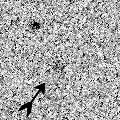
|
It will reach to 10.5 mag and will be observable in good condition in 2008 autumn. Now it is 16.1 mag (May 11, Ken-ichi Kadota), brightening as expected. It keeps observable in good condition for a long time while the comet is getting brighter slowly.
Date(TT) R.A. (2000) Decl. Delta r Elong. m1 Best Time(A, h)
May 19 22 5.17 -11 51.6 5.342 5.410 88 16.3 5:21 (214, 63)
May 26 22 6.87 -11 24.9 5.178 5.355 94 16.2 5:26 (197, 65)
|

|
Now it is 17.6 mag (May 7, Ken-ichi Kadota). It will reach to 12 mag in 2008 summer. In the Northern Hemisphere, it keeps observable almost all time until that while the comet is brightening gradually. However, it goes to the southern sky and will never be observable again in the Northern Hemisphere after that.
Date(TT) R.A. (2000) Decl. Delta r Elong. m1 Best Time(A, h)
May 19 17 44.96 35 58.6 5.329 5.860 117 16.8 2:01 (180, 19)
May 26 17 39.18 36 2.6 5.247 5.808 119 16.7 1:28 (180, 19)
|

|
Now it is 16.6 mag (Apr. 28, Ken-ichi Kadota). It is outside of Jupiter's orbit. So it keeps 17 mag for a long time until 2007 summer. It keeps locating high and observable in good condition for a long time after this because it moves in the northern sky.
Date(TT) R.A. (2000) Decl. Delta r Elong. m1 Best Time(A, h)
May 19 13 55.64 38 46.6 6.921 7.429 116 16.8 22:08 (180, 16)
May 26 13 51.72 38 5.7 6.998 7.447 112 16.8 21:36 (180, 17)
|
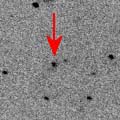
|
Now it is 17.3 mag (May 11, Ken-ichi Kadota). It will be observable at 16.5-17 mag in good condition in summer.
Date(TT) R.A. (2000) Decl. Delta r Elong. m1 Best Time(A, h)
May 19 21 1.17 9 14.3 5.670 5.866 96 17.0 5:17 (180, 46)
May 26 20 58.15 10 16.0 5.559 5.863 102 16.9 4:46 (180, 45)
|

|
It was observed at 18.5 mag in 2006 autumn. It passed the perihelion in 2007 May, and it was expected to reach to 16.5-17 mag in June and July. However, it is 18.1 mag now (May 19, Gary Hug), much fainter than expected. It did not brighten at all while getting closer to the sun.
Date(TT) R.A. (2000) Decl. Delta r Elong. m1 Best Time(A, h)
May 19 20 51.94 -4 57.0 2.776 3.165 103 17.2 5:07 (180, 60)
May 26 20 49.12 -6 42.3 2.659 3.168 111 17.1 4:37 (180, 62)
|
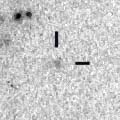
|
Now it is 17.0 mag (May 13, Ken-ichi Kadota). It keeps 17 mag until July when it starts getting lower in the evening sky. It will be observable again at 18 mag in 2008.
Date(TT) R.A. (2000) Decl. Delta r Elong. m1 Best Time(A, h)
May 19 13 44.41 -11 23.5 3.833 4.741 150 17.1 21:57 (180, 66)
May 26 13 42.08 -11 14.2 3.892 4.744 143 17.2 21:27 (180, 66)
|
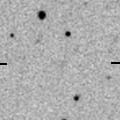
|
Now it is 18.2 mag (May 4, Ken-ichi Kadota). It will approach down to 0.4 A.U. to the sun in late October, and it is expected to reach to 6 mag. However, the condition in the Northern Hemisphere is very hard. It will be getting lower in the evening sky after this. The altitude becomes lower than 20 degree in early July, and lower than 10 degree in late July. The comet is still faint as 15.5 mag at that time. After conjunction with the sun, the comet will be brighter than 11 mag in late September, and will be 8 mag in mid October. But it locates extremely low, slightly over the horizon in the morning sky. It goes to the southern sky in late October, then it will never be observable again. In the Southern Hemisphere, it becomes unobservable in July. But it will appear in the evening sky at 7.5 mag in mid November. Then it keeps observable while fading gradually, although it will not locate very high.
Date(TT) R.A. (2000) Decl. Delta r Elong. m1 Best Time(A, h)
May 19 10 10.04 28 33.6 2.809 2.932 86 17.4 18:30 (178, 26)
May 26 10 6.68 28 47.8 2.842 2.839 79 17.3 18:27 (171, 26)
|
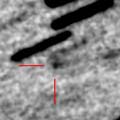
|
Now it is 17.5 mag (May 4, Ken-ichi Kadota). But, it will be lower in the evening sky while fading in June.
Date(TT) R.A. (2000) Decl. Delta r Elong. m1 Best Time(A, h)
May 19 10 55.82 7 14.8 1.713 2.202 104 17.3 19:09 (180, 48)
May 26 11 2.65 6 40.3 1.780 2.194 99 17.4 18:49 (180, 48)
|
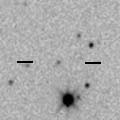
|
Now it is 17.5 mag (May 11, Catalina Sky Survey). It keeps observable in the evening sky at 17.5 mag until autumn when it becomes fainter than 18 mag, although the altitude will be getting lower after May.
Date(TT) R.A. (2000) Decl. Delta r Elong. m1 Best Time(A, h)
May 19 10 39.71 17 22.9 1.279 1.729 97 17.6 18:53 (180, 38)
May 26 10 49.49 16 43.4 1.311 1.699 93 17.6 18:36 (180, 38)
|

|
Fading is slower than expected. It was 17.7 mag still on Apr. 29 (Ken-ichi Kadota). It will be observable at 17-18 mag for some more time.
Date(TT) R.A. (2000) Decl. Delta r Elong. m1 Best Time(A, h)
May 19 15 21.10 60 41.1 5.192 5.453 99 17.8 23:32 (180, -6)
May 26 15 8.88 60 45.0 5.292 5.514 97 17.8 22:53 (180, -6)
|
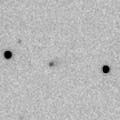
|
It reached to 16 mag in early 2006. Now it is 17.8 mag (Apr. 28, Ken-ichi Kadota). It will be fading very slowly from 17 mag to 18 mag until summer. In the Northern Hemisphere, it keeps locating high.
Date(TT) R.A. (2000) Decl. Delta r Elong. m1 Best Time(A, h)
May 19 13 44.59 32 17.3 5.498 6.082 121 17.8 21:57 (180, 23)
May 26 13 41.96 31 34.2 5.589 6.112 116 17.8 21:27 (180, 24)
|
|
![]()
 C/2005 YW ( LINEAR )
C/2005 YW ( LINEAR ) P/2007 H1 ( McNaught )
P/2007 H1 ( McNaught ) C/2006 M4 ( SWAN )
C/2006 M4 ( SWAN ) C/2006 V1 ( Catalina )
C/2006 V1 ( Catalina ) C/2006 OF2 ( Broughton )
C/2006 OF2 ( Broughton ) C/2007 G1 ( LINEAR )
C/2007 G1 ( LINEAR ) C/2002 VQ94 ( LINEAR )
C/2002 VQ94 ( LINEAR ) C/2005 S4 ( McNaught )
C/2005 S4 ( McNaught ) C/2006 S2 ( LINEAR )
C/2006 S2 ( LINEAR ) 99P/Kowal 1
99P/Kowal 1 C/2007 F1 ( LONEOS )
C/2007 F1 ( LONEOS ) 87P/Bus
87P/Bus 125P/Spacewatch
125P/Spacewatch C/2004 B1 ( LINEAR )
C/2004 B1 ( LINEAR ) C/2004 D1 ( NEAT )
C/2004 D1 ( NEAT )![]()


























